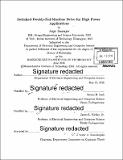| dc.contributor.advisor | Steven B. Leeb and James L. Kirtley, Jr. | en_US |
| dc.contributor.author | Banerjee, Arijit, Ph. D. Massachusetts Institute of Technology | en_US |
| dc.contributor.other | Massachusetts Institute of Technology. Department of Electrical Engineering and Computer Science. | en_US |
| dc.date.accessioned | 2016-12-05T19:56:30Z | |
| dc.date.available | 2016-12-05T19:56:30Z | |
| dc.date.copyright | 2016 | en_US |
| dc.date.issued | 2016 | en_US |
| dc.identifier.uri | http://hdl.handle.net/1721.1/105650 | |
| dc.description | Thesis: Ph. D., Massachusetts Institute of Technology, Department of Electrical Engineering and Computer Science, 2016. | en_US |
| dc.description | Cataloged from PDF version of thesis. | en_US |
| dc.description | Includes bibliographical references (pages 202-207). | en_US |
| dc.description.abstract | Converting electricity to mechanical motion is a foundation of modern civilization. A controllable "knob" is often necessary in these electromechanical energy conversion systems to achieve adjustable motion or a process control. An energy-efficient approach to realize this "knob" is through variable-speed drives (VSD), which are power-electronic based converters with associated control operating as an interface between the electrical machine and the electrical source. These drives are not only critical in a wide range of applications including industrial processes, electric propulsion systems, and power generation plants but also becoming increasingly relevant for optimizing energy consumption. For example, a motor without a VSD running at fixed speed can potentially waste 30% to 80% of energy in mechanical throttles located upstream from a compressor or downstream of a pump. In addition to being a controllable knob for energy conversion, these VSDs are configurable to support the electrical source, e.g., the electric grid, through appropriate reactive power support and controllable power factor - a vital feature required for the future electric grid comprising more complex electrical networks. However, merely 13% of global loads in mega-watt class high-power applications are driven by VSDs. At these higher power levels, the VSD design is significantly challenging due to the limited available power-electronic device ratings and allowable switching frequency leading to design trade-offs among size, efficiency, performance, reliability, and cost. This dissertation proposes a switched-doubly-fed machine (switched-DFM) drive that uses a parallel architecture for electromechanical energy conversion to reduce the required power processing capability of the power-electronic converter by two-thirds while operating seamlessly over a wide speed range. Additionally, the proposed architecture provides exciting opportunities for supporting the electric grid with reactive power not only through the VSD but also using the electrical machine. The approach confronts the challenges of high power electromechanical energy conversion from the perspective of electromagnetics, power electronics, circuit designs, embedded computing, and control to push the trade-off boundary for the VSD to be physically small, efficient, reliable, flexible, inexpensive, and electric-grid friendly. The thesis contributions include a design procedure for the proposed switched-DFM drive based on a required drive-torque-speed capability, a control architecture that can achieve seamless performance across the entire speed range from the perspectives of the electrical grid and the mechanical load, multiple transfer-switch circuit topologies enabling uninterrupted on-the-fly reconfiguration of the DFM, steady-state and dynamic performance comparison between different switched-DFM drive topologies, and an exploration of DFM electromagnetic design considerations that suit the proposed architecture. A lab-scale experimental setup that emulates an entire power system from generation to consumption is designed and built to demonstrate seamless, wide-speed range, and four-quadrant operation of the proposed switched-DFM drive. The proposed methodologies open up opportunities to create efficient, cost-effective, and sustainable solutions for high power electromechanical energy conversion systems. | en_US |
| dc.description.statementofresponsibility | by Arijit Banerjee. | en_US |
| dc.format.extent | 207 pages | en_US |
| dc.language.iso | eng | en_US |
| dc.publisher | Massachusetts Institute of Technology | en_US |
| dc.rights | M.I.T. theses are protected by copyright. They may be viewed from this source for any purpose, but reproduction or distribution in any format is prohibited without written permission. See provided URL for inquiries about permission. | en_US |
| dc.rights.uri | http://dspace.mit.edu/handle/1721.1/7582 | en_US |
| dc.subject | Electrical Engineering and Computer Science. | en_US |
| dc.title | Switched-doubly-fed-machine drive for high power applications | en_US |
| dc.type | Thesis | en_US |
| dc.description.degree | Ph. D. | en_US |
| dc.contributor.department | Massachusetts Institute of Technology. Department of Electrical Engineering and Computer Science | |
| dc.identifier.oclc | 963851421 | en_US |
